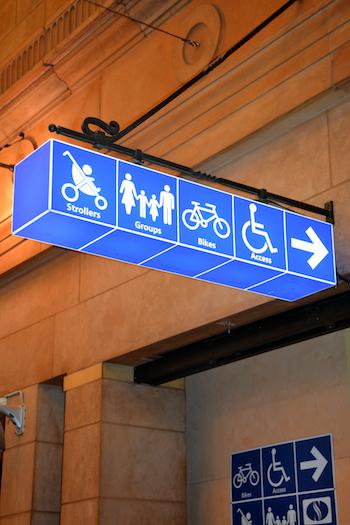What does that say?
Duration/age

When you are out walking or driving the car how do you know when to stop or where to turn? Do you have to wait for someone to tell you what to do or is there something else that helps you to know?
There are signs everywhere and they help us to know what to do and how to act. When you are out and about with your child point out the different signs that you notice. Ask them if they can work out what the signs say from the picture, symbol or number on the sign.
As you notice the signs with your child see if you can sort the signs into groups for pedestrians, road traffic or workers in buildings. Are they grouped by a common image, colour or number on the sign?
Once you have grouped them ask your child to look carefully at the signs to see if they notice the small differences.
These are both bike lane signs. They both have a bike symbol on them. This bike sign tells us it is only for use in the morning. The other one can be used all day and night.
Skills this activity improves
Why does this matter?
When children notice the different types of signs around them they are exploring the different ways we share and communicate language and information.
Often we think of language as only spoken or written. Language can also be a picture or an image. Signs help us to understand what to do or how to act. By noticing the different signs around them children are learning that signs and symbols convey meaning in the same way that a written or spoken word can.
What does this lead to?
As children notice the different colours, shapes, images and how the image is placed on the sign they are developing an understanding that pictures and symbols can tell a story. We can change the story or message of what to do by adding other words, numbers or an image.
Language to use
- Safety signs, advertising signs, traffic signs, pedestrian crossing signs, speed limit signs
- Road, pedestrian, car
- Fixed signs, temporary signs, traffic control signs
- Direction, instruction, information, rules
- Building signs, shop signs
- Entry, exit
Questions to use
- Are all signs the same?
- Why do we have signs?
- What do I look for if I want to find a police station?
- How would I know if there is a railway crossing ahead?
- How do I know how fast to go?
Useful tips
- Take a camera with you as you search for the signs. If you take a photo of ones that seem the same you can compare them afterwards.
- Talk to your child about safety signs.
- Remember to talk to your child in your home language.
More ideas
- Make a book of signs.
- Take photos of the signs you see. Print them off and cut them out to use when playing with cars or building a city.
- Talk about where you are going and try to predict what signs you will see along the way.
Variation by age
Three to five year olds
- Take some photos on your search for signs.
- Make a set of dominoes from the photos.
- Make a bingo card to take with you in the car as you travel. Your child can mark off the signs you see along the way.
- Make a set of snap cards from the photos.
Questions to ask
- Are these the same or different?
- What does this symbol mean?
- What do we do when we see a sign for a school crossing?
- How do we know when to stop?
Language to use
- Same, different
- Word, letter, symbol, picture, number
- Road sign, shop sign, instructions, advertising, safety sign


